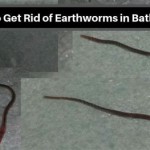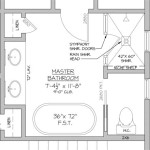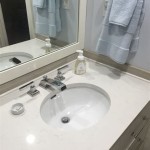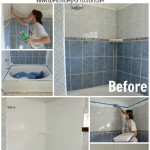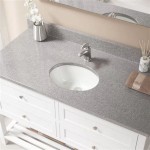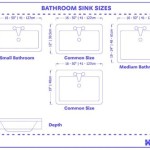Bathroom Sink Still Clogged After Cleaning P Trap: Troubleshooting and Solutions
A clogged bathroom sink is a common household nuisance, frequently stemming from the accumulation of hair, soap scum, and other debris within the drainpipe. A typical first approach to resolving this issue involves cleaning the P-trap, the curved section of pipe located beneath the sink. This component is designed to trap debris and prevent sewer gases from entering the home. However, situations arise where even after meticulously cleaning the P-trap, the sink remains clogged. This article explores the various reasons why a bathroom sink might remain stubbornly clogged even after P-trap cleaning and provides detailed troubleshooting steps and potential solutions.
When a bathroom sink remains clogged after cleaning the P-trap, it indicates that the blockage lies elsewhere in the drain system. The location of the blockage could be further down the drain line, within the vent pipe, or even in the main sewer line. The type of blockage can also vary; it could be a larger accumulation of the same materials found in the P-trap, or it could be a more solid object obstructing the flow. Furthermore, the drainpipe material itself, whether PVC, copper, or cast iron, can influence the severity and location of clogs due to factors like corrosion or inner pipe irregularities.
Before proceeding with more advanced troubleshooting, it's crucial to re-examine the initial P-trap cleaning procedure. Ensure all components of the P-trap were thoroughly cleaned and that no residual debris remains. Check the connecting pipes for any visible obstructions. If this thorough re-examination reveals no issues, the problem likely lies beyond the easily accessible P-trap, necessitating a more comprehensive approach.
Identifying Potential Causes Beyond the P-Trap
Several factors can contribute to a persistent sink clog even after cleaning the P-trap. Understanding these potential causes is crucial for effective troubleshooting and selecting the appropriate remedy.
Firstly, the blockage might be located further down the drain line. The horizontal pipe extending from the P-trap connects to the vertical drainpipe leading to the main plumbing system. This section is prone to accumulating debris, especially if the sink is used for washing items containing small particles or if the drainage system has accumulated grease and soap buildup over time. In older homes, pipe corrosion can also restrict water flow and contribute to clogging.
Secondly, the vent pipe system may be malfunctioning. The vent pipe allows air to enter the drainpipe, preventing a vacuum from forming and ensuring proper drainage. If the vent pipe is blocked, the water flow will be significantly slowed or completely stopped. Common causes of vent pipe blockages include bird nests, leaves, and other debris that can accumulate over time, especially in exposed vent pipes on the roof.
Thirdly, the main sewer line could be the culprit. While less common, a blockage in the main sewer line will affect all drains in the house, including the bathroom sink. Signs of a main sewer line blockage include multiple clogged drains, gurgling sounds from drains, and water backing up in toilets or showers. Addressing a main sewer line blockage typically requires professional intervention.
Troubleshooting Steps and Solutions
Once the potential causes have been identified, a systematic approach to troubleshooting and implementing solutions is necessary. The following steps outline various techniques, ranging from simple to more complex, to resolve a stubborn sink clog.
Plunging: The first step beyond P-trap cleaning should be to use a plunger specifically designed for sinks. Ensure the sink contains enough water to cover the cup of the plunger. Create a tight seal around the drain opening and vigorously plunge up and down for several minutes. The force of the plunging can often dislodge debris further down the drainpipe. If the water begins to drain, continue plunging to ensure the clog is completely cleared.
Drain Snakes (Augers): If plunging proves ineffective, a drain snake, also known as an auger, is the next logical step. A drain snake is a flexible tool designed to reach further down the drainpipe to break up or retrieve the clog. Slowly insert the drain snake into the drain opening, rotating it as it advances. When resistance is encountered, continue rotating the snake to break up the blockage and pull it out. After removing the snake, run hot water down the drain to flush away any remaining debris.
There are different types of drain snakes available, including manual and powered versions. Manual drain snakes are suitable for smaller clogs and DIY use, while powered drain snakes offer more power and are better suited for tougher blockages. Selecting the appropriate drain snake depends on the severity and location of the clog, as well as the individual's experience and comfort level with using power tools.
Chemical Drain Cleaners: While readily available, chemical drain cleaners should be used with caution and as a last resort. These products contain harsh chemicals that can damage pipes, especially older ones, and pose health risks. If using a chemical drain cleaner, carefully follow the manufacturer's instructions and wear appropriate protective gear, such as gloves and eye protection. Avoid mixing different types of drain cleaners, as this can create dangerous fumes. Furthermore, repeated use of chemical drain cleaners is generally discouraged due to their corrosive effects on plumbing systems.
Baking Soda and Vinegar: A more environmentally friendly alternative to chemical drain cleaners is a mixture of baking soda and vinegar. Pour one cup of baking soda down the drain, followed by one cup of vinegar. Let the mixture fizz for about 30 minutes, then flush with hot water. The chemical reaction between baking soda and vinegar can help to loosen and dissolve minor clogs without the harmful effects of chemical drain cleaners. This method is most effective for clogs composed of organic matter, such as hair and soap scum.
Checking the Vent Pipe: If the drain is slow or gurgling sounds are heard, the vent pipe might be blocked. This task often requires accessing the roof to inspect the vent pipe opening. Exercise extreme caution when working on the roof and consider hiring a professional if uncomfortable with heights or roof work. Clear any visible debris from the vent pipe opening. A garden hose can be used to flush water down the vent pipe to dislodge any further obstructions. If the vent pipe continues to drain slowly, it might require further inspection with a plumber's snake.
Inspecting the Pop-Up Stopper Mechanism: The pop-up stopper mechanism, located beneath the sink, is another potential source of clogs. This mechanism often traps hair and debris, which can accumulate over time and restrict water flow. Remove the stopper and thoroughly clean it, removing any visible debris. Also, inspect the surrounding area for any lodged material causing the blockage. Reinstall the stopper and test the drainage to ensure the problem has been resolved.
When to Call a Professional Plumber
While many sink clogs can be resolved using the methods described above, certain situations warrant professional assistance. Recognizing these circumstances can save time, money, and prevent further damage to the plumbing system.
If the clog persists after attempting multiple troubleshooting steps, including plunging, snaking, and using alternative cleaning methods, it indicates a more serious blockage or a problem deeper within the plumbing system. In such cases, a professional plumber has the experience and tools to diagnose and resolve the issue effectively.
Suspected issues in the main sewer line, such as multiple clogged drains throughout the house or water backing up in other fixtures, require immediate professional attention. A blocked main sewer line can lead to significant damage and health hazards, making prompt intervention essential.
If there is any indication of pipe damage, such as leaks or corrosion, it is crucial to consult a professional plumber. Attempting to repair damaged pipes without the necessary expertise can exacerbate the problem and lead to further complications.
Older plumbing systems, especially those with cast iron pipes, are more prone to corrosion and blockages. If the home has an older plumbing system and experiences frequent clogs, it might be time for a professional inspection and potential pipe replacement.
Professional plumbers have specialized equipment, such as video cameras for inspecting drain lines and hydro-jetting machines for clearing stubborn blockages. They can accurately diagnose the cause of the clog and implement the appropriate solution without causing further damage to the plumbing system. Furthermore, they can identify underlying issues that might be contributing to the problem and recommend preventative measures to avoid future clogs.
Preventative Measures to Avoid Future Clogs
Preventing clogs in the bathroom sink is far easier and more cost-effective than dealing with them after they occur. Adopting proactive measures can significantly reduce the frequency of sink clogs and maintain a healthy plumbing system.
One of the most effective preventative measures is to install a drain strainer or mesh screen over the drain opening. This will catch hair, soap scum, and other debris before they enter the drainpipe. Regularly clean the strainer to prevent it from becoming clogged itself.
Avoid pouring grease, oil, or food scraps down the drain. These substances can solidify and accumulate within the drainpipe, leading to stubborn clogs. Dispose of these materials properly in the trash or compost bin.
Regularly flush the drain with hot water. This can help to dissolve and wash away any minor accumulations of soap scum or other debris before they solidify and cause a clog. Running hot water down the drain for a few minutes each week can make a significant difference.
Periodically clean the pop-up stopper mechanism to remove accumulated hair and debris. This is a simple task that can prevent clogs from forming in this area.
Consider using enzyme-based drain cleaners on a regular basis. These cleaners contain beneficial bacteria that break down organic matter in the drainpipe, helping to prevent clogs from forming. They are a safer and more environmentally friendly alternative to chemical drain cleaners.
By implementing these preventative measures, bathroom sink clogs can be significantly reduced, leading to a more efficient and trouble-free plumbing system.

How To Unclog A Bathroom Sink Hana S Happy Home

How To Clear A Clogged Drain Reviews By Wirecutter

Clear A Sink Clogged Past The Trap In Minutes Our Recipes For Success

When Snaking A Drain Doesn T Work Ben Franklin Plumbing

Clear A Sink Clogged Past The Trap In Minutes Our Recipes For Success
What Is The Issue If P Trap Clean But Sink Won T Drain Quora

What Should You Do If Your Toilet Trap Becomes Clogged

Why Is My Sink Clogged Mike Diamond
We Re Plumbers Here S What Would Never Do In A Home Bathroom

How To Unclog A Drain Bob Vila
Related Posts
